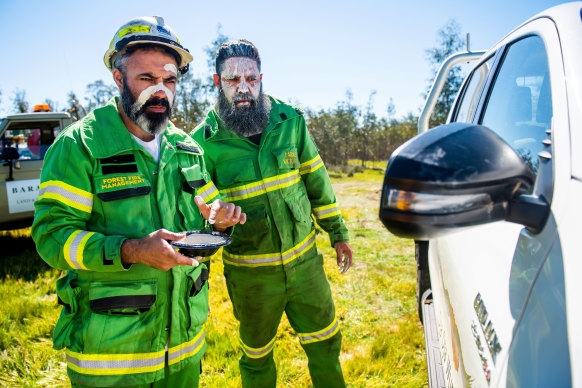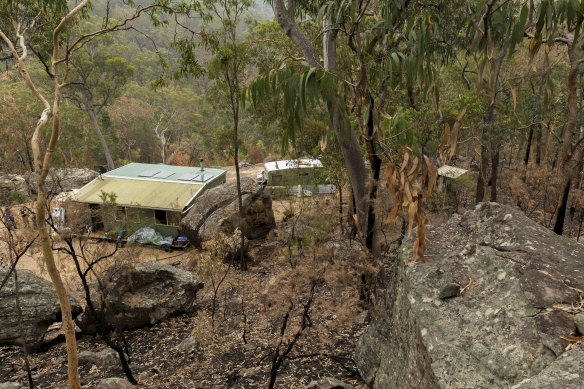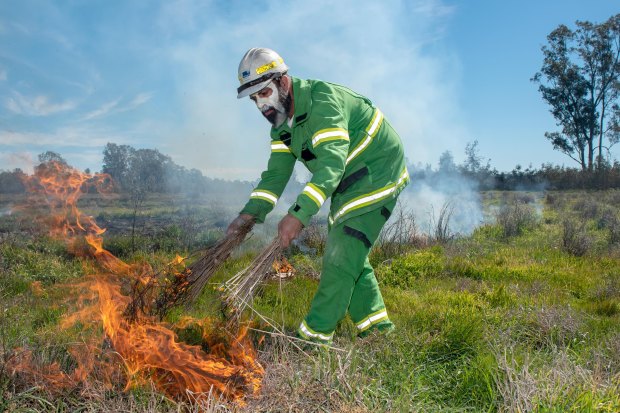Explainer
- Explainer
- Indigenous culture
What is cultural burning?
Catastrophic bushfires have led to a heightened interest in Indigenous burning practices. How do Aboriginal experts use fire to care for their land?
By Miki Perkins
A cool, gentle, creeping fire came to the bushland that surrounds the Tang Tang and Thunder swamps in central Victoria, north of Bendigo, in 2019. It burnt gently through grasslands and connected up with other fires lit on the forest floor to create a mosaic effect.
This fire was lit by Dja Dja Wurrung people, including employees of Forest Fire Management Victoria, and their non-Aboriginal colleagues. It was the first cultural burn in the area in 170 years.
It was a momentous day, says Trent Nelson, the chairperson of the Dja Dja Wurrung Clans Aboriginal Corporation. In the years since cultural burning had been used, the landscape had become degraded and "sick". The region, which includes the towns of Daylesford, Bendigo and Boort, used to be cloaked in box-ironbark forests and woodlands but is now one of the most profoundly altered landscapes in Victoria, where agriculture, urban settlement and mining have left ecosystems fragmented.
Nelson learnt cultural burning – known as djandak wii or "country fire" – from his father, who learnt from his father before him and other elders. "We don’t make it really, really hot, we burn cool. It’s a lot slower than planned burns."
In the wake of last summer's catastrophic bushfires, there is heightened national interest in the role of Aboriginal cultural burning, sometimes called traditional burning. What is it, and how does it work? And can it reduce the threat of out-of-control fires in an era of climate change?
Aboriginal and Torres Strait Islander people should be aware that this article contains the images and names of people who have passed away.
Above: A burn on Gunbower Island in May 2018. Source: DELWP, Victoria
What is cultural burning?
For at least 65,000 years, Aborigines have used cultural land-management practices – including fire – to care for country (the term used by Aboriginal and Torres Strait Islander people to describe family origins, ownership and associations with particular areas of Australia).
Cultural burns are done by Indigenous custodians, or people given their permission and guidance. The use of fire is specific to each location, its animals and flora and their totemic and cultural value.
There are many interconnected objectives, which include protecting cultural or natural assets by maintaining the health of surrounding country, ceremony, habitat protection and fuel reduction. But fuel reduction – targeted burning to reduce the amount or density of foliage – is often not the primary objective.

Dja Dja Wurrung men Mick Bourke and Trent Nelson apply ochre paint before a planned burn using traditional methods in Boort, Victoria.Credit: Brendan McCarthy/DELWP
Indigenous land management was critical to preventing catastrophic bushfires, the Royal Commission into National Natural Disaster Arrangements was told in 2020, but Aboriginal voices had been ignored. "Cultural land management is not an add-on or an enhancement, it’s not a practice that can simply be grafted onto the regime of non-Indigenous land managers," Euahlayi man and Australian National University researcher Bhiamie Eckford-Williamson told the commission.
He also said that short-term funding was a barrier to Aboriginal land management. "It is not possible for groups to develop, to recruit, train and retain staff to maintain that corporate memory, to build relationships with non-Indigenous land-management agencies over time, if their funding is not secure," he explained.
Most Australian wildfires occur in the northern tropical savanna, and most cultural burning also occurs in northern Australia – about 70 per cent of projects occur in the Northern Territory, Queensland or Western Australia, according to the CSIRO.
In Western Australia, for example, the Great Western Woodlands, 16 million hectares of temperate woodland, heathland and mallee, are cared for in part by the Ngadju Nation and the Ngadju Rangers Group. The Ngadju undertake cultural burns at a certain time — when the grass is green, or a few days after
rain, or when rain is coming. In the warmer seasons, the fire must be started in the morning before the sea breezes rise.
Everywhere we have open woodland, the ground being partially covered with a most thin pasture.
Charles Darwin, 1836
In early colonial artwork, letters and journals, there is considerable historical evidence of Aboriginal use of fire. In 1836, naturalist Charles Darwin visited Sydney and commented on the sparsity of the trees and the prevalence of grasslands, much of which is now thick scrub. "The extreme uniformity in the character of the Vegetation, is the most remarkable feature in the landscape of the greater part of New S. Wales. Everywhere we have open woodland, the ground being partially covered with a most thin pasture," he wrote.
The use of “prescribed” or “hazard-reduction burning” is the process of applying fire to a predetermined area to achieve a desired outcome – usually the mitigation of the presence or severity of bushfires.
While there are some crossovers between the two practices, cultural burning may also be used to clear important pathways or manage vegetation around significant sites. But where fire is a concern, it may be possible to use cultural burning where prescribed burning is unsafe – because of the warming climate, it is becoming more challenging for land-management agencies to find periods of time when prescribed burns can be safely lit.
How does cultural burning work?
Most cultural burns use "cool" fires – smaller, low-intensity fires – which reduce the risk of extreme, high flames that can burn whole trees and forest canopies. Protecting the canopy is considered paramount in cultural burning because it holds many precious resources – insects, birds' nests, bats and shade. And canopy removal fundamentally alters the surrounding ecosystem – sunlight breaks through and dries out the soil. Unlike hazard-reduction burns, where lines of fire can create walls of flame, cultural burning tends to use spot ignitions, creating a mosaic of fires. This leaves space for wildlife to escape.
Oliver Costello, a Bundjalung man from the Northern Rivers region of NSW and chief executive of the Firesticks Alliance, says cultural fire may not be about fuel reduction. He gives the example of a burn near Guyra in NSW where Banbai rangers used cultural burning around an art site that contained a painting of an echidna, a Banbai totem.
The fire encouraged the growth of native grasses and reduced the density of vegetation so that echidnas could move around the area more easily and find food. Rangers saw more evidence of echidnas after burning and more growth of a local endangered species, the black grevillea.
"The country has a culture and we’re a part of that culture. When you apply the right fire to that culture, you’re maintaining your identity with country, maintaining the land," Costello says.
Above: A small area of fire in a cultural burn on Gunbower Island, May 2018. Source: DELWP, Victoria
How do you learn cultural burning?
Despite European colonisation and land theft, Aboriginal cultural lore and knowledge of burning practices remain across Australia. A revival is being led through initiatives such as the Firesticks Alliance, an Indigenous-led network that does training, on-ground cultural burning and scientific monitoring of its ecological effects.
Fire knowledge has been handed down through generations of Aboriginal families. Costello learnt from his stepfather, a senior Dalabon man from Arnhem Land, who knew how to use fire the traditional way. When his stepfather died, Costello realised how much knowledge had gone with him. It motivated Costello to go to university and focus on Indigenous knowledge systems and sustainability in an era of climate change. “In NSW land management, no one was using cultural burning methodology and protocols, and no one was supporting people to burn their country,” he says.
Over the past decade, the Firesticks Alliance has organised fire workshops in Cape York with Dr Tommy George, a Kuku Thaypan elder. George and his brother, Dr George Musgrave, (now both deceased) were granted honorary doctorates for their knowledge of fire management and ecology. Workshops such as those held on the south coast of NSW and on Yorta Yorta country at Barmah on the Murray River draw participants from around the country.
Firesticks Alliance practitioners burn on private and public land, including in NSW national parks. Since the 2019-20 summer bushfires, the alliance has fielded a huge increase in inquiries from private landholders and public land-management agencies. One landowner in NSW credits cultural burning with saving structures on his remote bush property during the Gospers Mountain fire.

The owners of this house in Ngurrumpaa on the NSW Central Coast believe a cultural burn saved their property.Credit: Rhett Wyman
Does cultural burning work?
There is a small but growing body of Western academic research on cultural burning and it chimes with what Aboriginal experts have always known. For example, scientists analysing data on fire-scarred land in northern Australia on behalf of the Nature Conservancy, an environmental organisation, found that early dry-season cultural burning reduced the extent of destructive late-season fires by about 30 per cent compared with the four years before the burning program began.
There has been healthy plant and grass regeneration, including kangaroo grass, a traditional dietary staple, and yam daisy.
In Victoria, traditional owners have also noticed a change. There have been more than a dozen cultural burns on Dja Dja Wurrung country, and Trent Nelson says there has been healthy plant and grass regeneration, including kangaroo grass, a traditional dietary staple, and yam daisy, which is used for fibre.
Cultural burning is being brought into Victoria’s existing burning program, with more planned in addition to “fuel management” burning done by Forest Fire Management Victoria. They will be conducted in areas nominated by traditional owners, who will lead the burns.
The CSIRO has published a number of papers that find cultural burning delivers a range of social and economic benefits for Aboriginal people, including the protection of heritage, the retention of language and identity and career development opportunities.

Mick Bourke lights a fire using traditional methods in Boort, Victoria in September 2019.Credit: Brendan McCarthy/DELWP
Can it help against climate-fuelled bushfires?
Aboriginal people were devastated to see the damage wrought by last summer's catastrophic bushfires, says Oliver Costello. “We have this knowledge about land management ... and we’re really sad because people haven’t been listening to us,” he says. “We have been saying this is going to happen: this country is really thick and it will burn.”
Prime Minister Scott Morrison has argued hazard-reduction burns are at least as important as cutting carbon emissions in Australia’s fight against bushfires, although the Climate Council and federal opposition say this is a distraction from the government’s lack of action on climate change.
We are drawing on the oldest, living knowledge system around fire and it works for us.
Oliver Costello
But analysis from forest scientists at the University of Melbourne found hazard-reduction burns had little to no effect in slowing the severe fires that devastated more than 5 million hectares across NSW. It would be best used around assets to protect them from less intense fires, the research found.
Former Victorian emergency management commissioner Craig Lapsley describes cultural burning as a “holistic land-management strategy” and says last summer's bushfires showed that land-management agencies need to test new approaches.
“I don’t think we valued Indigenous people, and what they believed as a long-term well-tested strategy, I don’t think we have taken that seriously at all,” says Lapsley.
Costello wants land-management agencies to support the Firesticks Alliance to develop a national mentoring program so there can be 100 skilled cultural fire practitioners nationwide. "We are drawing on the oldest, living knowledge system around fire and it works for us,” he says. “But you also need to share some of the resources and power you have.”
Above: Lighting small fires as part of a burn on Gunbower Island in 2018. Source: DELWP, Victoria.
Let us explain
If you'd like some expert background on an issue or a news event, drop us a line at explainers@smh.com.au or explainers@theage.com.au. Read more explainers here.